
NATURAL PRODUCT RESEARCH
Scope & Guideline
Exploring the Essence of Nature's Compounds
Introduction
Aims and Scopes
- Natural Product Chemistry:
The journal emphasizes the isolation and characterization of novel compounds from natural sources, including plants, fungi, and marine organisms. This encompasses a diverse range of chemical classes such as terpenoids, alkaloids, flavonoids, and polyketides. - Biological Activity Assessment:
Research articles often include in vitro and in vivo evaluations of the biological activities of isolated compounds, focusing on their potential therapeutic effects, including anticancer, anti-inflammatory, antimicrobial, and neuroprotective properties. - Pharmacological Mechanisms:
The journal also addresses the mechanisms of action of natural products, utilizing modern techniques such as molecular docking, network pharmacology, and proteomics to elucidate how these compounds exert their effects at the cellular and molecular levels. - Synthetic Approaches:
In addition to natural extraction, the journal features studies on the synthesis of bioactive compounds and their derivatives, exploring structure-activity relationships to enhance pharmacological efficacy. - Traditional Medicine Integration:
A significant focus is placed on the connection between traditional medicine and modern pharmacology, investigating how traditional uses of natural products can inform contemporary therapeutic applications.
Trending and Emerging
- Targeted Cancer Therapies:
Recent publications have highlighted the potential of natural products in developing targeted therapies for various cancers. This includes studies on specific pathways, such as the PI3K/Akt and MAPK pathways, demonstrating the relevance of natural compounds in modern oncological treatments. - Microbiome and Natural Products:
There is an increasing focus on the interaction between natural products and the microbiome, exploring how these compounds can modulate microbiota and influence health outcomes, particularly in metabolic and gastrointestinal diseases. - Advanced Analytical Techniques:
The use of cutting-edge analytical methods, such as UHPLC-MS, molecular docking, and metabolomics, is on the rise, allowing for more comprehensive profiling of natural products and their biological activities. - Natural Products in Neuroprotection:
Emerging themes in neuropharmacology are evident, with several studies investigating the potential of natural compounds to protect against neurodegenerative diseases, such as Alzheimer’s and Parkinson’s, highlighting their relevance in addressing global health challenges. - Sustainable and Green Chemistry Practices:
There is a noticeable trend towards incorporating sustainable practices in the extraction and synthesis of natural products, reflecting a broader commitment to environmental responsibility and the use of renewable resources.
Declining or Waning
- Marine Natural Products:
Although marine-derived compounds have historically been a significant area of interest, recent publications indicate a decrease in the number of studies focused on marine natural products compared to terrestrial sources. - Classical Pharmacognosy Techniques:
Traditional methods of extraction and analysis, such as simple solvent extractions or basic chromatographic techniques, are becoming less common as researchers increasingly adopt more sophisticated and high-throughput methodologies. - General Reviews on Natural Products:
The frequency of broad reviews summarizing natural product chemistry has declined, suggesting a trend towards more specialized studies that delve into specific compounds or mechanisms rather than covering the field in general. - Focus on Single Compounds:
The trend of focusing research on individual compounds rather than complex mixtures or extracts appears to be waning, as there is a growing interest in holistic approaches that consider the synergistic effects of multiple components.
Similar Journals
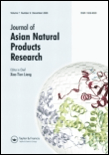
JOURNAL OF ASIAN NATURAL PRODUCTS RESEARCH
Exploring the Essence of Asian Natural InnovationsJOURNAL OF ASIAN NATURAL PRODUCTS RESEARCH is a prestigious publication in the field of natural products, focusing on valuable research spanning analytical chemistry, pharmacology, and complementary medicine. Published by Taylor & Francis Ltd in the United Kingdom, this journal has established itself as a key resource for academics and professionals seeking to explore advancements in drug discovery and organic chemistry. With a converged publication timeline from 1998 to 2024, the journal boasts several commendable category quartiles as of 2023, reflecting its robust standing in the research community: Q2 in Complementary and Alternative Medicine, Q3 in multiple domains including Analytical Chemistry and Organic Chemistry, and Q4 in Molecular Medicine. Although it currently does not offer open access, the journal remains a valuable compendium for empirical research and innovative studies in areas such as pharmacology and medicinal chemistry. Researchers, professionals, and students alike will find the JOURNAL OF ASIAN NATURAL PRODUCTS RESEARCH to be an essential platform for sharing groundbreaking findings and fostering collaborations that lead to significant advancements in science and health.

International Journal of Peptide Research and Therapeutics
Pioneering Research at the Intersection of Biochemistry and Drug Discovery.International Journal of Peptide Research and Therapeutics, published by Springer, is a distinguished platform that bridges the gap between peptide research, therapeutic applications, and interdisciplinary sciences. With a focus on providing high-quality research, this journal covers a broad array of topics including analytical chemistry, biochemistry, drug discovery, and bioengineering, reflecting the essential role peptides play in modern medicine and biotechnology. The journal holds a respectable Q3 quartile ranking across its relevant fields as of 2023, underscoring its position as a noteworthy contributor to ongoing discussions in peptide science. Operating under an Open Access model, it aims to enhance the dissemination of knowledge and foster collaborative research efforts globally. Since its inception in 1996, the journal has evolved through various converged years to continue attracting submissions that push the boundaries of peptide research and its therapeutic potential. Researchers, professionals, and students are encouraged to engage with this journal to explore cutting-edge findings and contribute to the advancing field of peptide science.
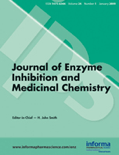
JOURNAL OF ENZYME INHIBITION AND MEDICINAL CHEMISTRY
Pioneering Research in Enzyme InhibitionJOURNAL OF ENZYME INHIBITION AND MEDICINAL CHEMISTRY, published by Taylor & Francis Ltd, is a premier open-access journal that has been at the forefront of research in the field of medicinal chemistry since its inception in 1985. With an ISSN of 1475-6366 and an E-ISSN of 1475-6374, this journal boasts a prestigious reputation reflected in its impressive Q1 rankings across critical categories such as Drug Discovery and Pharmacology as of 2023. Situated in the United Kingdom, it plays a vital role in disseminating high-quality research that addresses the burgeoning needs of drug discovery and enzyme inhibition methodologies. The journal supports full open access, providing a platform for researchers, professionals, and students to share significant findings and innovations widely. With a robust impact factor, the JOURNAL OF ENZYME INHIBITION AND MEDICINAL CHEMISTRY is indispensable for any academic or professional involved in the pharmacological sciences, offering an unparalleled insight into the latest advancements in therapeutic strategies and drug development.
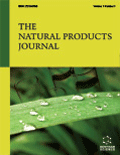
Natural Products Journal
Unveiling Nature's Secrets for Innovative MedicineNatural Products Journal, a leading publication by Bentham Science Publishers, primarily focuses on the rapidly evolving field of Natural Products and their applications in Complementary and Alternative Medicine as well as Drug Discovery. With an ISSN of 2210-3155 and an E-ISSN of 2210-3163, this journal serves as an essential platform for researchers, professionals, and students dedicated to exploring the critical role of natural compounds in health and medicine. Since its inception in 2011, it has consolidated its reputation, achieving a Q3 ranking in Complementary and Alternative Medicine and a Q4 ranking in Drug Discovery as of 2023, illustrating its growing influence within the academic community. Although it currently does not operate as an Open Access journal, it remains a vital resource for cutting-edge research and developments in natural products, offering insightful contributions that pave the way for innovative therapeutic strategies. Located in the Netherlands, the journal is pivotal for those looking to stay at the forefront of research in natural substances and their multifaceted applications.
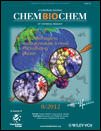
CHEMBIOCHEM
Pioneering insights in molecular biology and beyond.CHEMBIOCHEM is a premier interdisciplinary journal published by WILEY-V C H VERLAG GMBH, dedicated to advancing knowledge in the fields of Biochemistry, Molecular Biology, Molecular Medicine, and Organic Chemistry. With an impactful presence since its inception in 2000 and a convergence through to 2024, the journal has established itself as a vital resource for researchers, professionals, and students alike, evidenced by its notable quartile rankings in 2023—Q2 in Biochemistry, Molecular Biology, and Molecular Medicine, and Q1 in Organic Chemistry. While it does not currently offer Open Access options, CHEMBIOCHEM remains a respected platform for disseminating high-quality research, reflected in its Scopus rankings, where it holds a credible position in various chemistry categories. By fostering innovative studies and discussions, CHEMBIOCHEM aims to contribute to the understanding and advancement of biochemical and molecular principles critical to contemporary science and healthcare.

Natural Products and Bioprospecting
Advancing Discoveries in Natural Product ScienceNatural Products and Bioprospecting is a prestigious academic journal published by SPRINGERNATURE, dedicated to advancing research in the fields of analytical chemistry, biochemistry, plant science, organic chemistry, and pharmacology. With an impact factor that positions it within the top quartiles across multiple categories, this journal serves as a crucial platform for disseminating groundbreaking findings and innovative methodologies focusing on the potential of natural products. Since adopting its Open Access model in 2011, it has broadened its reach, allowing global accessibility to cutting-edge research. The journal, based in Singapore, aims to foster interdisciplinary collaboration and encourages submissions that explore the intricate relationships between natural products and their applications in food science, toxicology, and pharmacology. Its well-respected status is further highlighted by impressive Scopus ranks and a growing H-index, reinforcing its significance in the scientific community. Researchers, professionals, and students alike can benefit from the rich repository of knowledge that Natural Products and Bioprospecting continuously curates and disseminates, making it an invaluable resource in the quest for innovative solutions derived from nature.

Marine Drugs
Pioneering Research on Ocean-Derived TherapeuticsMarine Drugs is a leading peer-reviewed journal dedicated to the field of drug discovery and development derived from marine resources. Published by MDPI in Switzerland since 2003, this open-access journal has established itself as a prominent platform for the dissemination of high-quality research, evidenced by its Q1 rankings in 2023 across multiple categories including Drug Discovery, Pharmaceutical Science, and Pharmacology, Toxicology, and Pharmaceutics. With a global readership, Marine Drugs specializes in the exploration of bioactive compounds from marine organisms, advancing our understanding of natural product chemistry and its applications in pharmacology and therapeutics. The journal actively encourages submissions from researchers worldwide, showcasing innovative studies, reviews, and methodologies that contribute to the growing field of marine biotechnology. Researchers, professionals, and students alike will find Marine Drugs an invaluable resource for enhancing their knowledge and fostering collaborations in marine drug research.

Journal of Pharmacy & Pharmacognosy Research
Empowering Research in Pharmaceutical SciencesJournal of Pharmacy & Pharmacognosy Research, published by JOURNAL PHARMACY & PHARMACOGNOSY RESEARCH-JPPRES, is a prominent open-access journal established in 2013, headquartered in Antofagasta, Chile. With a focus on the fields of Complementary and Alternative Medicine, Drug Discovery, Pharmaceutical Science, Pharmacology, and Pharmacy, this journal is recognized for its commitment to advancing research and disseminating knowledge within these important areas. With a current impact factor that reflects its academic rigor and relevance, the journal has achieved substantial recognition, evident by its Q2 and Q3 quartile rankings in multiple categories, indicating its growing influence on the scientific community. The Scopus rankings further highlight its standing in pharmacy and pharmacological disciplines, providing a valuable platform for researchers, professionals, and students to share their findings and insights. With its open access model, the journal ensures that high-quality research is available to a global audience, paving the way for collaborative advancements in pharmaceutical sciences.

Natural Product Communications
Fostering Collaboration in Natural Product ResearchNatural Product Communications is an esteemed open-access journal published by SAGE Publications Inc, dedicated to the exploration and dissemination of knowledge concerning natural products in diverse fields, including Complementary and Alternative Medicine, Drug Discovery, and Pharmacology. Since its inception in 2006 and continuing through its converged years until 2024, the journal has gained recognition with a robust focus on plant science and the medicinal properties of natural products. With a commendable impact factor reflected in its category quartiles (Q3 across key domains), Natural Product Communications serves as a vital resource for researchers and professionals who aim to further the understanding of the therapeutic potential of natural compounds. As an open-access journal since 2020, it ensures wide accessibility to its published research, thereby facilitating collaboration and innovation within the scientific community. This commitment to excellence makes Natural Product Communications a crucial platform for advancing research in the holistic and pharmacological sciences.
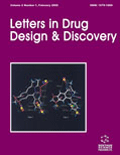
Letters in Drug Design & Discovery
Pioneering Research for a Healthier FutureLetters in Drug Design & Discovery is an esteemed journal dedicated to advancing the fields of Drug Discovery and Molecular Medicine. Published by Bentham Science Publishers, this journal offers a platform for the dissemination of innovative research and advanced methodologies, enhancing collaboration among researchers and professionals in pharmaceutical sciences. Despite its current Q4 ranking in Drug Discovery and Molecular Medicine and Q3 in Pharmaceutical Science for 2023, the journal is committed to improving its presence in the academic community by providing quality, peer-reviewed publications that cover various aspects of drug design and discovery, including novel therapeutic approaches and methodologies. With a focus on both foundational and cutting-edge research from around the globe, Letters in Drug Design & Discovery is pivotal for those seeking to stay abreast of developments in drug development and molecular research. Researchers are encouraged to submit their work, engage with the burgeoning field, and contribute to the ongoing dialogue driven by this journal, which spans the years from 2005 to 2024. While the journal does not currently offer open access, its contributions remain accessible to a wide range of academic and professional audiences.